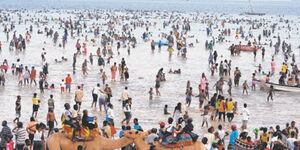The Kenya Meteorological Department (Kenya Met) has listed areas expected to experience storms as well as those wreathing under high temperatures that have hit 30 degrees Celsius.
In an update on Tuesday, the department revealed that rainfall is expected to continue over several parts of the country between Tuesday, October 17 and Monday, October 23.
As a result, some areas including the Highlands East and West of the Rift Valley, the Lake Victoria Basin, North-eastern and North-western Kenya will experience isolated storms in the week under review.
Counties that fall on the Highland East and West of the Rift Valley are Nyandarua, Nyeri, Kirinyaga, Murang'a, Kiambu, Meru, and Embu.
Those of the Lake Basin counties include Siaya, Kisumu, Homabay, Migori, Kisii, Nyamira and Trans Nzoia among others.
North-Eastern and North-Western counties are Tharaka, Turkana, West Pokot, Samburu, Marsabit, Mandera, Wajir, Garissa and Isiolo.
The department further disclosed that the Coast, North-Eastern and North-Western Kenya should prepare for high average daytime (maximum) temperatures of more than 30 degrees Celsius.
Coast counties include Mombasa, Tana River, Kilifi, Lamu and Kwale.
"A few areas in the Highlands East and West of the Rift Valley, the South-eastern lowlands and the Rift Valley will experience low average night-time (minimum) temperatures of less than 10°C," read the update in part.
The caution comes at a time when the National Environment Management Authority (NEMA) issued guidelines to Kenyan citizens over the impending El Nino.
The authority warned of potential flooding in select sections and asked Kenyans to be cautious of their environment.
Citizens were also warned to avoid areas prone to flooding and landslides including riparian land and hilltops.
"In previous flooding incidents, urban areas have experienced clogging of the drainage infrastructure by waste, especially from pack-aging, textiles and diapers among others," read the notice in part.
"This exacerbates the flooding menace leading to loss of life and property. Further, post-consumer waste degrades our wetland ecosystems such as rivers, lakes, swamps, and oceans among others."












